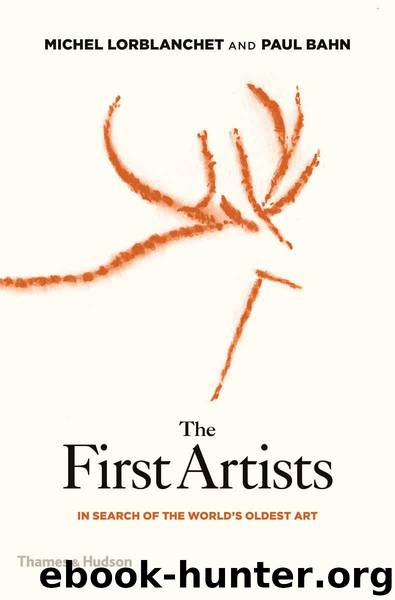The First Artists: In Search of the World's Oldest Art by Bahn Paul & Lorblanchet Michel

Author:Bahn, Paul & Lorblanchet, Michel [Bahn, Paul]
Language: eng
Format: azw3
Publisher: Thames & Hudson
Published: 2017-07-10T16:00:00+00:00
41. The Acheulian ‘proto-figurine’ from Berekhat Ram (Israel), dating to around 280,000–250,000 years ago. It is a largely natural volcanic nodule, just 3.5 cm (1.4 in.) long, but there has been much debate over the extent to which it was modified by early humans.
In the current state of research, one should favour the opinion of those very few prehistorians who have examined and directly studied this remarkable piece (Goren-Inbar 1986; Marshack 1997; d’Errico & Nowell 2000). Goren-Inbar sensibly provided a precise, full-size drawing; it is the small size and modest appearance of this little pebble (which could have passed unnoticed by prehistoric people and prehistorians alike) that astonish one immediately, an impression that is somewhat betrayed by the macro-photos that increase its visual impact. She distinguished three artificial grooves: one horizontal and two longitudinal on either side of the piece. In her view the transverse groove demarcates a rounded mass that represents a ‘head’, whereas the lateral grooves, perpendicular to the first, highlight protuberances that represent ‘arms’.
Marshack (1997) carried out a detailed microscopic examination of the nodule, and published excellent colour photographs with his description. According to him, there is ‘a slightly rounded head at the rear but a relatively flat “face” in front’. The groove accentuating the ‘neck’ is straight at the back and curved at the front to highlight the ‘chin’. The end of the neck groove from the rear arcs upward and passes over the neck groove coming from in front, which angles downward, in a kind of mismatch. In the mass of the ‘head’, Marshack saw a slightly convex ‘face’ flanked by two small lateral masses depicting ‘hair’. The ‘chest and shoulders’ were partially scraped and flattened, the right arm was bent at the elbow. On the left side, however – in contrast to Goren-Inbar – he felt there was no ‘arm’. All these traits suggested a crude image of a heavy, large-bosomed woman.
The photographs showed a few troubling details, such as some parts of the neck, or the mismatch of the ends of the groove in front of and behind the neck (FIG. 42), which seem to show a localized artificial deepening of the horizontal groove; yet no internal striation that could confirm this impression can be seen in the groove. The scraping marks on the chest and shoulders are also invisible. Marshack’s article did not eliminate from the mind of the reader (who has no access to the real object) a general impression of subjectivity due to the fact that, despite their quality, most of the photos are hard to read, and the description includes anatomical terms (head, arm, chest, hair, etc.) which implicitly suggest from the start that this is a ‘female figurine’, whereas this should have been demonstrated through an objective analysis, using neutral terms.
Download
This site does not store any files on its server. We only index and link to content provided by other sites. Please contact the content providers to delete copyright contents if any and email us, we'll remove relevant links or contents immediately.
| Anthropology | Archaeology |
| Philosophy | Politics & Government |
| Social Sciences | Sociology |
| Women's Studies |
Mysteries by Colin Wilson(3394)
People of the Earth: An Introduction to World Prehistory by Dr. Brian Fagan & Nadia Durrani(2701)
Ancient Worlds by Michael Scott(2622)
Foreign Devils on the Silk Road: The Search for the Lost Treasures of Central Asia by Peter Hopkirk(2433)
The Splendid and the Vile by Erik Larson(2354)
The Memory Code by Lynne Kelly(2352)
Come, Tell Me How You Live by Mallowan Agatha Christie(2212)
Lost Technologies of Ancient Egypt by Christopher Dunn(2194)
The Earth Chronicles Handbook by Zecharia Sitchin(2179)
The Plantagenets by Dan Jones(2038)
Last Chance to See by Douglas Adams(1933)
The Return of the Gods by Erich von Daniken(1895)
Wars of the Anunnaki by Chris H. Hardy(1681)
Keeper of Genesis by Graham Hancock(1607)
Before the Dawn by Nicholas Wade(1574)
The Cygnus Mystery by Andrew Collins(1520)
The Message of the Sphinx by Graham Hancock(1482)
Fragile Lives by Stephen Westaby(1421)
Hieroglyphs: A Very Short Introduction by Penelope Wilson(1312)
